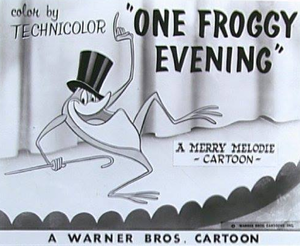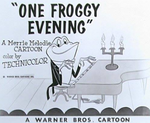One Froggy Evening
| One Froggy Evening | |
|---|---|
 Lobby card. | |
| Production company | Warner Bros. Cartoons |
| Distributor | Warner Bros. Pictures The Vitaphone Corporation |
| Release date | December 31, 1955 |
| Run time | 6:53 |
| Starring | Bill Roberts |
| Producer(s) | Edward Selzer |
| Music composition | Milt Franklyn |
| Story | Michael Maltese |
| Animation | Ben Washam Ken Harris Abe Levitow Richard Thompson |
| Director(s) | Charles M. Jones |
| Series navigation | |
| ← Previous | Next → |
| Title card | |

| |
| Second title card | |

| |
One Froggy Evening is the four hundred and fourth Merrie Melodies theatrical short. It was distributed by Warner Bros. Pictures and The Vitaphone Corporation on December 31, 1955. It was written by Michael Maltese, produced by Edward Selzer, and directed by Chuck Jones.
In the 1950s, a construction worker unearths a metal box hidden inside of a cornerstone. When he finds that the box inside contains a live frog performing ragtime dance numbers, his greed takes a toll as he tries to exploit the frog's talents for monetary gain.
Detailed summary
Memorable quotes
Michigan: Hello, ma baby! Hello, ma honey! Hello, ma ragtime gal! Send me a kiss on wire. Baby, ma heart's on fire! If you refuse me, honey ya lose, then you'd be left alone. So baby, telephone, and tell me I'm you're own!
Characters
In order of appearance: | ||||||||||||
| ||||||||||||
Organizations
- Acme
- Acme Building and Wrecking Co., Inc.
- Acme Theatrical Agency
- Acme Building Disintegrators
Locations
- Earth
- United States
- J.C. Wilber Building
- Acme Theatrical Agency building
- Hippodrome theater
- Construction worker's house
- City park
- Psychopathic hospital
- Tregoweth Brown Building
- United States
Objects
- Crowbar
- Metal box
- J.C. Wilber Building commemorative document
- "Free admission" sign
- "Free beer" sign
- Disintegration gun
Production
Development

The premise of One Froggy Evening has some similarity to that of the 1944 Columbia Pictures film Once Upon a Time, centering on a dancing caterpillar that is kept in a shoebox, and starring Carry Grant. Some of the frog's physical movements are evocative of ragtime-era entertainers such as Bert Williams, who was known for sporting a top hat and cane, and for his distinct use of the cakewalk dance as performed by the frog in the short.
Jones and his animators studied actual frogs to achieve the frog's transitions from a regular animal to a high-stepping entertainer.[1]
Filming
It was copyrighted in 1955 (MCMLV).
Music
The score was composed by Milt Franklyn. The majority of songs performed by the frog were ragtime numbers written after he was presumably sealed into the cornerstone, dated 1862. "The Michigan Rag" was an original song created for the short, and was written by Franklyn, Maltese, and Jones.
Songs
- "Hello! Ma Baby" by Ida Emerson and Joseph E. Howard (1899)
- "The Michigan Rag" by Milt Franklyn, Michael Maltese, and Chuck Jones
- "Come Back to Éireann" by Claribel (Charlotte Alington Barnard) (1866)
- "I'm Just Wild About Harry" by Eubie Blake and Noble Sissle for Shuffle Along (1921)
- "Throw Him Down, McCloskey" by John W. Kelly (1890)
- "Won't You Come Over To My House" by Harry Williams and Egbert Van Alstyne (1906)
- "Largo al factotum" by Gioachino Rossini for The Barber of Seville (1816)
- "Please Don't Talk About Me When I'm Gone" by Sidney Clare, Sam H. Stept, and Bee Palmer
Crew credits
- Layouts: Robert Gribbroek
- Backgrounds: Philip De Guard
Release
Dates are in order of release:
- United States: December 31, 1955 in theatres; December 6, 1969 (Blue Ribbon reissue)[2]
Behind the scenes
- The title is a pun on the phrase, "one foggy evening." 'Nuff said.
- The MPAA certificate number is 16892.
- The construction site of the Tregoweth Brown Building is named after film editor Treg Brown.
Legacy
- Although unnamed in the short, the frog was eventually given the name "Michigan J. Frog" by Chuck Jones, after "The Michigan Rag." He stated that he started calling the character "Michigan Frog" in the 1970s, and during an interview with writer Jay Cocks, Jones decided to adopt "J" as the Frog's middle initial, after the interviewer.[3]
- While edited for time, One Froggy Evening was featured as a segment in Bugs Bunny's 3rd Movie: 1001 Rabbit Tales.
- In 1995, it received a direct sequel in the form of the Looney Tunes theatrical short, Another Froggy Evening.
- In 2003, the United States Library of Congress deemed the short "culturally, historically, or aesthetically significant," making it the third animated short to be inducted to the National Film Registry, after What's Opera, Doc? and Duck Amuck.[4]
In popular culture
- In the 1987 film Spaceballs, during the scene in which Lone Star and Barf stop by Gus's Galaxy Grill, an alien bursts out of a customer's stomach and sings "Hello! Ma Baby." Lone Starr and Barf become perplexed by this and promptly ask for a check following the alien's dance routine.
- In the Lego Ninjago episode "Tick Tock", Zane reveals to his friends that he is a robot and presses a button on his mainframe that makes him start singing "Hello! Ma Baby."
Critical reception
In 1994, it was voted No. 15 in The 50 Greatest Cartoons, as selected by members of the animation field.[5]
In the documentary Chuck Jones: Extremes & Inbetweens – A Life in Animation, Steven Spielberg called One Froggy Evening "the Citizen Kane of the animated short".
In other languages
| Language | Name | Meaning |
|---|---|---|
| French | La Légende du ténor grenouille | The Legend of the Frog Tenor |
| German | Der singende Frosch | The Singing Frog |
| Italian | Solo per te io canto | Only for you I sing (lit.) |
| Russian | Один лягушачий вечер | One frog evening (lit.) |
Home availability
- In the United States:
- October 7, 1985: Warner Home Video releases A Salute to Chuck Jones on VHS.
- November 1999: Warner Home Video releases Looney Tunes The Collector's Edition: Musical Masterpieces on VHS.
- November 2, 2004: Warner Home Video releases Looney Tunes Golden Collection: Volume 2 on DVD.
- November 2, 2004: Warner Home Video releases Looney Tunes Spotlight Collection: Volume 2 on DVD.
- November 15, 2011: Warner Home Video releases Looney Tunes Platinum Collection: Volume 1 on Blu-ray.
- May 26, 2015: Warner Home Video releases Looney Tunes Musical Masterpieces on DVD.
References
- ↑ Maltin, Leonard (1980). Of Mice and Magic: A History of American Animated Cartoons. New York: New American Library. p. 265. ISBN 0-452-25993-2.
- ↑ "Boxoffice-February.23.1970". yumpu.com. Retrieved May 20, 2024.
- ↑ Ebert, Roger (2006-01-15). "Chuck Jones: Three Cartoons (1953–1957)". rogerebert.com. Retrieved from original on March 4, 2006. Retrieved May 20, 2024.
- ↑ Whitson, James R. (December 17, 2003). "Pixar's Tin Toy and WB's One Froggy Evening added to the National Film Registry". Animated Views. Retrieved May 20, 2024.
- ↑ Beck, Jerry (1994). The 50 Greatest Cartoons: As Selected by 1,000 Animation Professionals. Turner Publishing. ISBN 978-1878685490. Retrieved May 20, 2024.